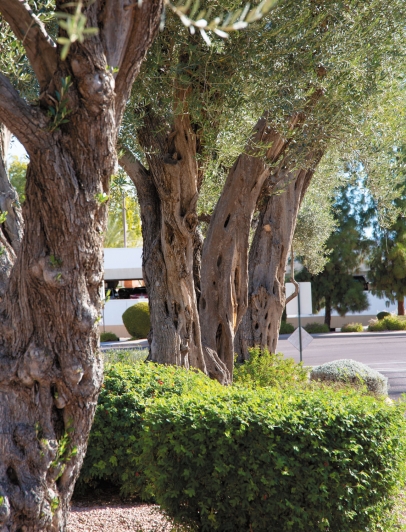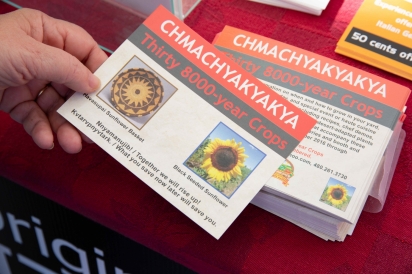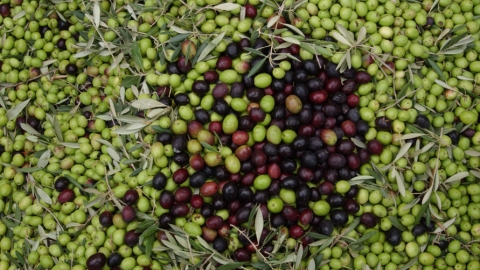Old Town Scottsdale's Olive Legacy
It is serendipitous that the Scottsdale Old Town Farmers Market is located on a site that has a rich history of food production stretching back thousands of years.
I learned some of this history at a recent Saturday Farmers Market “plant walk” conducted by Mark Lewis, an ethnobotanist and agricultural historian who coordinates educational talks, cooking demos and family-friendly food programs at the market for the series “Original Arizona.”
In the beginning, the town we know as Scottsdale was called “Vashai” by the O’Odham people who lived here from around 380AD until after the Civil War. The name refers to the abundant local sedge that desert fauna thrived on. The O’Odham hunted game and gathered the sedge, mesquite pods, prickly pear, saguaro and cholla cactus fruits, as well as other native plants. They raised turkeys and cultivated corn, beans, squash, sunflowers, amaranth and other ancient agricultural crops. The land and people were productive and thrived.
In 1888, after the Native people had been relocated and the land became available to Anglo settlers, Winfield Scott, a retired U.S. Army chaplain, bought 640 acres of Salt River Valley land where Old Town is today. The original Arizona canal would be built adjacent to his land, affording irrigation and the opportunity for commercial agricultural production.
His farm was extensive. Along with citrus, cotton and feed crops for his cattle and chickens, he produced potatoes, peanuts, corn, apples, grapes and stone fruits such as plums, peaches and apricots. He also planted almonds, pistachios and, especially, olive trees.
The olive is a long-lived tree, surviving 300–600 years, and sometimes as long as 1,000 years—centuries longer than other fruit or nut trees. Hardy and boasting a deep taproot, the olive grows well in hot, arid places with marginal soil.
Not admired for its beauty, it nonetheless has character. With its dense, striated wood, gnarly twisted trunk and leathery watertight leaves, the olive tree is a symbol of longevity and endurance. It will even grow again after being cut down.
The oldest surviving examples of olive trees in the Americas are found at the San Javier Viggé Mission garden, established in 1699 by the Spanish Jesuits in central Baja California. They are truly enormous, with girths about 30 feet around. They still produce small, dark, pungent olives, which are served to visitors to the mission.
Most famously the olive tree is considered a sign of peace: After Noah’s Old Testament ordeal with the flood, the dove brought him an olive branch to let him know that God’s wrath had abated, and that dry land and settlement were again possible.
Chaplain Scott may have planted the olive trees in Scottsdale as much for their religious symbolism as for their utility. Whatever his intentions, some of the 131-year-old olive trees remain on the streets of Old Town, still looking spry. You can see them on 2nd Street at Civic Center, in front of the Town offices. More olive trees grow on the median around the corner on Drinkwater Boulevard. These trees once marked the boundaries of Scott’s fields.
Most Saturdays during the market season, Mark Lewis offers walking tours to see these trees and various medicinal and food plants growing around the market. (Look for his booth: Chmachyakyakya Kurikuri: 8,000 Year Crops, Ancient Future Foods Remembered). Along the way he points out other remnant food trees in the neighborhood that were planted by Mexican and Yaqui families, laborers who came in the 1900s to work in the citrus groves and cotton fields. Their dwellings and garden plots were razed during the urban renewal of the 1970s, but a huge old pecan tree, a fig tree and a handful of buildings can still be seen.
On February 23, from 9 to 11am, Scottsdale community historian Joan Fudala will join Lewis at the market to celebrate Scott’s birthday week and his local legacies. See and hear more about the City of Scottsdale’s humble beginnings as a farming and ranching community, producing food crops, cotton and livestock.
Replanting for Arbor Day
In recent years, storms have ravaged the palo verde trees on 1st Street in Old Town. A few have been removed, others drastically pruned. Many of the trees around the Scottsdale Center for the Arts have been taken out. The shade these trees once provided the community is sorely missed. Lewis proposes a community-supported 2019 Arbor Day planting to commemorate the 10th anniversary of the Scottsdale Farmers Market, the 121st anniversary of the first Arbor Day spring planting of ash trees by Scott, and the 131st anniversary of the planting of the surviving olive trees.









